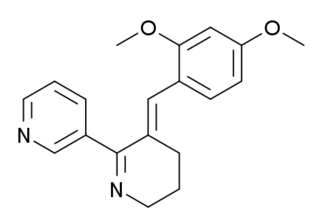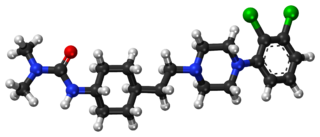
Renzapride is a prokinetic agent and antiemetic which acts as a full 5-HT4 agonist and partial 5-HT3 antagonist. It also functions as a 5-HT2B antagonist and has some affinity for the 5-HT2A and 5-HT2C receptors.

Muraglitazar is a dual peroxisome proliferator-activated receptor agonist with affinity to PPARα and PPARγ.

Dianicline (SSR-591,813) is a drug developed by Sanofi-Aventis which acts as a partial agonist at neural nicotinic acetylcholine receptors. It is subtype-selective, binding primarily to the α4β2 subtype. It is being developed as a medication for the treatment of nicotine dependence to assist in smoking cessation. Dianicline is very similar to the already marketed drug varenicline and it is unclear what advantages it will have over the older drug, although it may have an improved side effect profile. It has been through human trials up to Phase II, although results have not yet been reported. Drug development has been discontinued after reporting of unfavourable results during Phase III trials.

GTS-21 is an investigational drug that has been studied for its potential therapeutic uses, particularly in the treatment of neurodegenerative diseases and psychiatric disorders.

Itopride (INN; brand name Ganaton) is a prokinetic benzamide derivative. These drugs inhibit dopamine and acetylcholine esterase enzyme and have a gastrokinetic effect. Itopride is indicated for the treatment of functional dyspepsia and other gastrointestinal conditions. It is a combined D2 receptor antagonist and acetylcholinesterase inhibitor.

Mitemcinal is a motilin agonist derived from the macrolide antibiotic, erythromycin. It was discovered in the labs of Chugai Pharma. Mitemcinal is orally administered and it is believed to have strong promotility effects. Promotility drugs relieve symptoms of reflux by speeding the clearance of acid from the oesophagus and stomach. The parent compound, erythromycin, has these characteristics, but mitemcinal lacks the antibiotic properties of erythromycin.
Naluzotan is a serotonergic drug of the phenylpiperazine class that was under investigation by EPIX Pharmaceuticals Inc for the treatment of generalized anxiety disorder and major depressive disorder. It acts as a selective and potent 5-HT1A receptor partial agonist, readily stimulating prolactin responses, though it has also been found to bind to and activate the σ receptor. Naluzotan was well tolerated in clinical trials, with more patients in the control group dropping out due to adverse effects than in the active group in one study. The most frequently reported side effect was headache in 15% of patients. In addition, naluzotan demonstrated significant antidepressant and anxiolytic effects as per the HAM-D and MADRS and the HAM-A, respectively, in some trials, but in others it did not. In the end it was not found to be significantly superior enough to placebo and development was stopped.

Pomaglumetad (LY-404,039) is an amino acid analog drug that acts as a highly selective agonist for the metabotropic glutamate receptor group II subtypes mGluR2 and mGluR3. Pharmacological research has focused on its potential antipsychotic and anxiolytic effects. Pomaglumetad is intended as a treatment for schizophrenia and other psychotic and anxiety disorders by modulating glutamatergic activity and reducing presynaptic release of glutamate at synapses in limbic and forebrain areas relevant to these disorders. Human studies investigating therapeutic use of pomaglumetad have focused on the prodrug LY-2140023, a methionine amide of pomaglumetad (also called pomaglumetad methionil) since pomaglumetad exhibits low oral absorption and bioavailability in humans.

Repinotan (BAYx3702), an aminomethylchroman derivative, is a selective 5-HT1A receptor full agonist with high potency and efficacy. It has neuroprotective effects in animal studies, and was trialed in humans for reducing brain injury following head trauma. It was subsequently trialed up to phase II for treatment of stroke, but while side effects were mild and consisted mainly of nausea, repinotan failed to demonstrate sufficient efficacy to justify further clinical trials. However, repinotan continues to be investigated for other applications, and was found to be effective at counteracting the respiratory depression produced by morphine, though with slight reduction in analgesic effects.

Cariprazine, sold under the brand names Vraylar,Reagila and Symvenu among others, is an atypical antipsychotic originated by Gedeon Richter, which is used in the treatment of schizophrenia, bipolar mania, bipolar depression, and major depressive disorder. It acts primarily as a D3 and D2 receptor partial agonist, with a preference for the D3 receptor. Cariprazine is also a partial agonist at the serotonin 5-HT1A receptor and acts as an antagonist at 5-HT2B and 5-HT2A receptors, with high selectivity for the D3 receptor. It is taken by mouth.

Velusetrag (INN, USAN; previously known as TD-5108) is an experimental drug candidate for the treatment of gastric neuromuscular disorders including gastroparesis, and lower gastrointestinal motility disorders including chronic idiopathic constipation and irritable bowel syndrome. It is a potent, selective, high efficacy 5-HT4 receptor serotonin agonist being developed by Theravance Biopharma and Alfa Wassermann. Velusetrag demonstrates less selectivity for other serotonin receptors, such as 5-HT2 and 5-HT3, to earlier generation 5-HT agonists like cisapride and tegaserod.

Seladelpar is a PPARδ receptor agonist that is being investigated for drug use by Metabolex. According to a press release they are examining its potential use for the treatment of dyslipidemia, metabolic syndrome, type 2 diabetes, and non-alcoholic steatohepatitis (NASH). The compound was licensed from Janssen Pharmaceutica NV. The drug completed a phase II trial for primary biliary cholangitis. "Seladelpar demonstrated robust, dose-dependent, clinically significant, and durable improvements in biochemical markers of cholestasis and inflammation in patients with PBC at risk of disease progression. Seladelpar appeared safe and well tolerated and was not associated with any increase in pruritus." A phase III trial in patients with PBC also found reduced pruritus and improved liver biochemistry, despite being terminated early.

Piromelatine (Neu-P11) is a multimodal sleep drug under development by Neurim Pharmaceuticals. It is an agonist at melatonin MT1/MT2 and serotonin 5-HT1A/5-HT1D receptors. Neurim is conducting a phase II randomized, placebo controlled trial of cognitive and sleep effects in Alzheimer's disease.

Setmelanotide, sold under the brand name Imcivree, is a medication used for the treatment of genetic obesity caused by a rare single-gene mutation.

L-4-Chlorokynurenine is an orally active small molecule prodrug of 7-chlorokynurenic acid, a NMDA receptor antagonist. It was investigated as a potential rapid-acting antidepressant.

Relamorelin is a synthetic peptide, centrally penetrant, selective agonist of the ghrelin/growth hormone secretagogue receptor (GHSR) which is under development by Allergan pharmaceuticals for the treatment of diabetic gastroparesis, chronic idiopathic constipation, and anorexia nervosa. It is a pentapeptide and an analogue of ghrelin with improved potency and pharmacokinetics. In humans, relamorelin produces increases in plasma growth hormone, prolactin, and cortisol levels, and, like other GHSR agonists, increases appetite. As of June 2015, relamorelin is in phase II clinical trials for diabetic gastroparesis and constipation. The United States Food and Drug Administration (FDA) has granted Fast Track designation to relamorelin for diabetic gastroparesis. The development of the drug is uncertain as the most recent mention of it was in a 2019 SEC filing from the drug manufacturer lists the drug's expected launch year as 2024, but not in subsequent filings or press releases.

Ulimorelin is a drug with a modified cyclic peptide structure which acts as a selective agonist of the ghrelin/growth hormone secretagogue receptor (GHSR-1a).. Unlike many related drugs, ulimorelin has little or no effect on growth hormone (GH) release in rats. However, like ghrelin and other ghrelin agonists, ulimorelin does stimulate GH release with concomitant increases in insulin-like growth factor 1 (IGF-1) in humans. It has been researched for enhancing gastrointestinal motility, especially in gastroparesis and in aiding recovery of bowel function following gastrointestinal surgery, where opioid analgesic drugs used for post-operative pain relief may worsen existing constipation. While ulimorelin has been shown to increase both upper and lower gastrointestinal motility in rats, and showed promising results initially in humans, it failed in pivotal clinical trials in post operative ileus.

Tradipitant is an experimental drug that is a neurokinin 1 antagonist. It works by blocking substance P, a small signaling molecule. Originally, this compound was owned by Eli Lilly and named LY686017. VLY-686 was purchased by Vanda Pharmaceuticals from Eli Lilly and Company in 2012. Vanda Pharmaceuticals is a U.S. pharmaceutical company that as of November 2015 only has three drugs in their product pipeline: tasimelteon, VLY-686, and iloperidone.

Ulotaront is an investigational antipsychotic that is undergoing clinical trials for the treatment of schizophrenia and Parkinson's disease psychosis. The medication was discovered in collaboration between PsychoGenics Inc. and Sunovion Pharmaceuticals using PsychoGenics' behavior and AI-based phenotypic drug discovery platform, SmartCube. Ulotaront is in Phase III of clinical development.

Danavorexton is a selective orexin 2 receptor agonist. It is a small-molecule compound and is administered intravenously. The compound was found to dose-dependently produce wakefulness to a similar degree as modafinil in a phase 1 clinical trial. As of March 2021, danavorexton is under development for the treatment of narcolepsy, idiopathic hypersomnia, and sleep apnea. It is related to another orexin receptor agonist, firazorexton (TAK-994), the development of which was discontinued for safety reasons in October 2021.



















